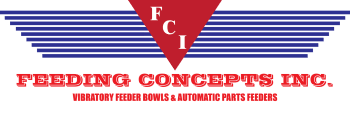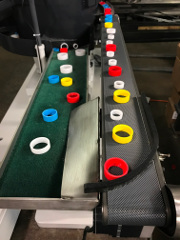A vibratory flex feeder can be utilized to run a vast array of part styles in one system without the need to purchase several feeders or one inconsistent, high-priced feeder. This is especially important for customers requiring a feeder to adapt to a new part in the lineup if needed. On a flex feeding system, the bowl is built to handle multiple sizes which will feed out in a general orientation.
With a typical flex feeding system you would be forced to give up a large portion of floor space for the bulk feeder and “wide” vibratory tray driver/conveyors. However, with a vibratory flex feeder you can keep the overall foot print minimal while still maintaining control of which parts you want to pick and place as needed. Overall costs compared to a multiple part system would be lower. In addition, the system would require virtually no changeover other than emptying out the system to run the next style part.
The operator would load the system like a normal parts feeder. Parts would proceed to start feeding in the bowl and make their way up the spiral tacks. But instead of selecting a “side for side” orientation or an “end for end”, the bowl would present the parts in one common orientation regardless of what side is up or down, leading or trailing. Once the parts are in that position, they would feed onto a special conveyor belt 36-48″ in travel length. The conveyor belt material is designed for vision inspection. Several options are available as each application is different. At that point the customer can inspect the parts on the conveyor belt at a particular field of view. This region is usually 1/4 of the way back from where the parts drop off and return back to the bowl. Good parts and bad parts will feed past this region. The conveyor runs faster than the bowl so this presents sufficient “gaps” to effectively look at each part independently. With a customer supplied signal the entire system can be paused for part pickup and then rebooted as needed. Any parts that do not pass will be fed back onto a return conveyor inline which will deliver the parts back into the bowl. The process runs constant until the next program change or part style changeover in which case a quick dump/purge gate would empty out all the parts from the bowl. Low cost robotics and technology updates have made flex feeders ideal for some applications. Consult us today if you think a flex feeder will be needed and we will be glad to help!

